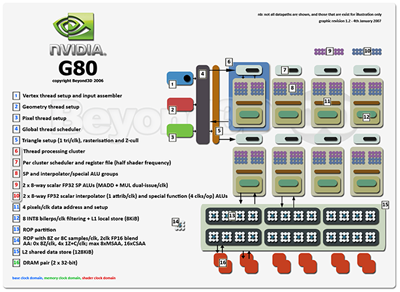Introduction
This article, part two of our NVIDIA G80 analysis, concerns itself with the chip's potential and realised image quality, from surface filtering to pixel output options and bits in between. The hardware does us a lot of favours, given its orthogonality in the ROP and filtering hardware, when explaining what it's capable of and displaying things empirically, so we get to keep it short and sweet.
With every new hardware generation comes an expectation of better image quality and more performance, and with G80 NVIDIA deliver that in pretty big spades. Outwardly the hardware is capable of all the big feature checkboxes, such as "HDR+AA" and very high quality filtering. Digging deeper you find true 8x multisample AA, coverage sample AA, filtering of data in non-linear colour spaces and more.
Our NVIDIA G80 Architecture and GPU Analysis hinted at what's possible from a filtering and antialiasing point of view, and it's here that we'll flesh it out a bit further.
We focus mostly on well-understood concepts and demonstrations for filtering and antialiasing, to illustrate what the hardware is capable of and to keep things short and easy enough to digest. The reality is there's not too much to say other than, "G80's good, here's an example of why", although we will touch on some shortcomings and where we think the hardware can do better.
We focus first on the ROP hardware (#13 on our overview diagram), where the chip performs final pixel ops like antialiasing, blending and memory writes, at the end of the chip. As we wrote in the first article, the 24 ROPs in a full G80 are divided into partitions of 4 each, each partition connecting to a 64-bit memory channel out to the DRAM pool for intermediary or final storage. It's those ROPs which lay down the law on a good amount of why G80 can draw such good looking pixels.

